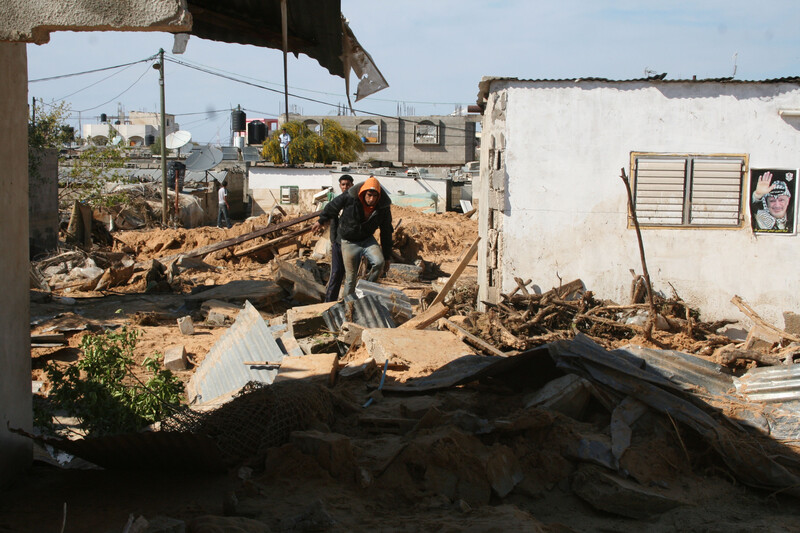The Electronic Intifada 4 July 2023

Umm al-Nasser is among the communities in Gaza threatened with displacement.
APA imagesZiyad Abu Hamad has been uprooted.
For the past few months, he has been living with his brother in Khan Younis refugee camp. Abu Hamad, his wife and their five children all have to sleep in the same room.
He had to move in with his brother after the Gaza authorities demolished his previous home in May.
Made from metal sheeting, it was located in al-Mawasi, a neighborhood of Khan Younis city. Abu Hamad, 42, and his family had lived in it for three years and received three notices from the local police before the demolition took place.
The police had told him that his home was on public land and it had been erected without the required permission.
Abu Hamad said that he appealed to the Hamas-led administration in Gaza “more than once.”
“I asked them to give me a year so that I could find a solution,” he said. “It was all to no avail.”
He works in a shop selling household appliances two days a week. Because his income is small, he cannot afford to rent an apartment.
“The work I have is only enough to bring food to my children,” he said.
Al-Mawasi is one of several areas in Gaza where residents have either had their homes demolished or been threatened with demolition.
Powerless
Saad Abu Jamal dreads being removed from the village where he has lived for more than two decades.
So far, Abu Jamal – a father of six – has received two notices from the authorities in Gaza, telling him that he must leave his home.
“Where am I supposed to go?” he asked. “I am unemployed. I have asked officials to find me a decent job so that I can move, pay rent and feed my children. But I’ve had no luck.”
Abu Jamal, 51, is part of the Palestinian Bedouin community in Um al-Nasser, which is located near Gaza’s boundary with Israel.
Abu Jamal has lived in Um al-Nasser since 2001.
He used to work in a clothing factory inside Israel. But he was blocked from doing so when the second intifada erupted in late 2000.
He moved to Um al-Nasser as he had lost his livelihood.
The community of Um al-Nasser faces demolition as the Gaza authorities claim that the village is built on public land without the required approval.
On a June afternoon last year, forces working for the Gaza administration arrived in Um al-Nasser, seeking to demolish a home.
When some locals threw stones in a bid to halt the demolition, the forces opened fire. Several people were wounded, one of them seriously.
Abu Jamal feels powerless.
With the uncertainty over his future, his family has even reconsidered plans to raise chickens or ducks. They would not be able to keep the animals, they fear, if the authorities made them relocate.
“My youngest children are 10 and 9,” he said. “They don’t know that we have no money to rent a house.”
Too steep?
Amal Shamali, a spokesperson for Gaza’s Land Authority, described communities living without permission on public land as “illegal.”
Such communities, she said, have been given “several opportunities” to reach an agreement with the administration.
The community of Bir al-Naja is unhappy with offers that the administration has made.
Mousa al-Daour, a representative of Bir al-Naja’s residents, is against a proposal which would allow his community to remain if they pay approximately $210 per square meter.
The administration says that the sum could be paid in installments over the course of a decade.
Al-Daour argues that the price suggested is too steep. Given the widespread poverty in Bir al-Naja, he is advocating that the price should be less than $100 per square meter.
Bir al-Naja covers an area of about 21 acres.
Previously uninhabited, it has played host to people who have moved out of the nearby Jabaliya refugee camp since the 1980s.
The community has developed at least partly because of protests. When Israel directly administered Gaza, it sought to declare Bir al-Naja a military zone.
Al-Daour and other political activists encouraged Palestinians to settle in Bir al-Naja as part of efforts to frustrate Israel’s plans.
Today, Bir al-Naja’s population stands at around 11,000.
Al-Daour, now 70, moved to Bir al-Naja in 1991. He has remained there despite repeated instructions to evacuate.
When one order was issued in 1998, al-Daour went to see Yasser Arafat, then president of the Palestinian Authority.
Arafat, he said, canceled an order to evacuate after learning of the residents’ objections and the fact they were poor.
In May 2021, Israel bombed Bir al-Naja during a major offensive against Gaza. Al-Daour’s two-story house was damaged.
In total, he has five sons, three of whom are married and live in his house.
“The public services are very bad in Bir al-Naja,” he said. “In the winter, the streets get flooded from rain. I suffer from diabetes and high blood pressure. I am afraid that something bad will happen to me.”
Ola Mousa is an artist and writer from Gaza.





